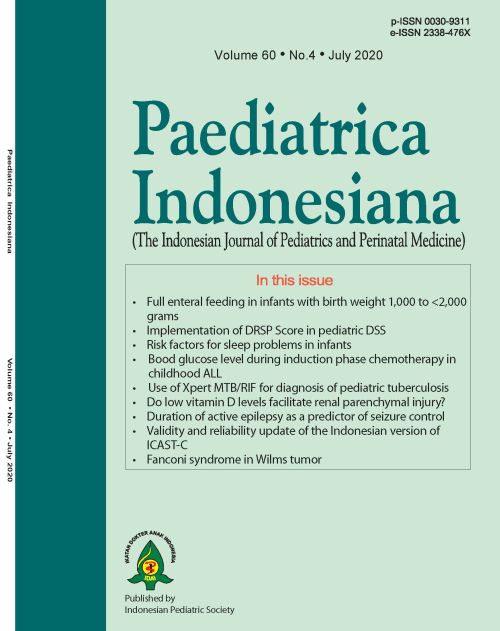Do low vitamin D levels facilitate renal parenchymal injury?
Abstract
Background Decreased vitamin D levels lead to an increase in infectious diseases, including urinary tract infections (UTIs).
Objective To assess serum vitamin D levels in children with renal parenchymal injury secondary to UTIs.
Methods Forty-three upper UTI patients and 24 controls, aged 1–15 years, were included. Vitamin D levels and other laboratory tests were obtained when they first admitted to hospital. 99mTc-labeled dimercaptosuccinic acid (DMSA) scans were performed to evaluate renal parenchymal injury.
Results Mean serum 25-hydroxyvitamin D (25(OH)D) was lower in the upper UTI group compared to the control group [18 (SD 9) vs. 23 (SD 10.6) ng/mL, respectively; P=0.045]. The upper UTI group was sub-divided into two groups, those with 22 (51.1%) and without 21 (48.8%) renal parenchymal injury. Mean 25(OH)D was significantly lower in patients with renal parenchymal injury [15.1 (SD 7.1) vs. 21 (SD 9.9) ng/mL, respectively; P=0.03]. The renal parenchymal injury cases were further sub-divided into two groups: 8 patients (36.3%) with acute renal parenchymal injury and 14 (63.6%) with renal scarring (RS), but there was no significant difference in 25(OH)D between these two groups [12.5 (SD 8.9) vs. 16.6 (SD 5.7) ng/mL, respectively; P=0.14).
Conclusion Decreased vitamin D is associated with renal parenchymal injury in children with upper UTIs. However, vitamin D is not significantly decreased in renal scarring patients compared to acute renal parenchymal injury patients.
References
2. Robinson JL, Finlay JC, Lang ME, Bortolussi R. Urinary tract infections in infants and children: diagnosis and management. Paediatr Child Health. 2014;19:315-19. DOI: 10.1093/pch/19.6.315.
3. Faust WC, Diaz M, Pohl HG. Incidence of post-pyelonephritic renal scarring: a meta-analysis of the dimercapto-succinic acid literature. J Urol. 2009;181:290-7; discussion 297-8. doi: 10.1016/j.juro.2008.09.039.
4. Park YS. Renal scar formation after urinary tract infection in children. Korean J Pediatr. 2012;55:367-70. doi: 10.3345/kjp.2012.55.10.367.
5. Jaksic E, Bogdanovic R, Artiko V, Saranovic DS, Petrasinovic Z, Petrovic M, et al. Diagnostic role of initial renal cortical scintigraphy in children with the first episode of acute pyelonephritis. Ann Nucl Med. 2011;25:37-43. doi: 10.1007/s12149-010-0431-5.
6. Peters C, Rushton HG. Vesicoureteral reflux associated renal damage: congenital reflux nephropathy and acquired renal scarring. J Urol. 2010;184:265-73. doi: 10.1016/j.juro.2010.03.076.
7. Munns CF, Shaw N, Kiely M, Specker BL, Thacher TD, Ozono K, et al. Global consensus recommendations on prevention and management of nutritional rickets. Horm Res Paediatr. 2016;85:83-106. doi: 10.1210/jc.2015-2175.
8. Gombart AF, Saito T, Koeffler HP. Exaptation of an ancient Alu short interspersed element provides a highly conserved vitamin D-mediated innate immune response in humans and primates. BMC Genomics. 2009;10:321. doi: 10.1186/1471-2164-10-321.
9. Jeng L, Yamshchikov AV, Judd SE, Blumberg HM, Martin GS, Ziegler TR, et al. Alterations in vitamin D status and anti-microbial peptide levels in patients in the intensive care unit with sepsis. J Transl Med. 2009;7:28. doi: 10.1186/1479-5876-7-28.
10. Hughes D, Norton R. Vitamin D and respiratory health. Clin Exp Immunol. 2009;158:20-5. DOI: 10.1111/j.1365-2249.2009.04001.x.
11. Tekin M, Konca C, Celik V, Almis H, Kahramaner Z, Erdemir A, et al. The association between vitamin D levels and urinary tract infection in children. Horm Res Paediatr. 2015;83:198-203. doi.org/10.1159/000370046.
12. Dadabhai AS, Saberi B, Lobner K, Shinohara RT, Mullin GE. Influence of vitamin D on liver fibrosis in chronic hepatitis C: a systematic review and meta-analysis of the pooled clinical trials data. World J Hepatol. 2017;9:278-87. doi: 10.4254/wjh.v9.i5.278.
13. Elder J. Urinary tract infections. In: Kliegman RM SB, St Geme JW, editors. Nelson textbook of pediatrics. 20th ed. Philadelphia: Elsevier; 2016. p. 2556-62.
14. Tekin M, Konca C, Gulyuz A, Uckardes F, Turgut M. Is the mean platelet volume a predictive marker for the diagnosis of acute pyelonephritis in children? Clin Exp Nephrol. 2015;19:688-93. DOI: 10.1007/s10157-014-1049-z.
15. Edefonti A, Tel F, Testa S, De Palma D. Febrile urinary tract infections: clinical and laboratory diagnosis, imaging, and prognosis. Semin Nucl Med. 2014;44:123-8. doi.org/10.1053/j.semnuclmed.2013.10.004.
16. Pecile P, Miorin E, Romanello C, Vidal E, Contardo M, Valent F, et al. Age-related renal parenchymal lesions in children with first febrile urinary tract infections. Pediatrics. 2009;124:23-9. DOI: 10.1542/peds.2008-1192.
17. Jones K, Assar S, Harnpanich D, Bouillon R, Lambrechts D, Prentice A, et al. 25(OH)D2 half-life is shorter than 25(OH)D3 half-life and is influenced by DBP concentration and genotype. J Clin Endocrinol Metab. 2014;99:3373-81. DOI: 10.1210/jc.2014-1714.
18. Gombart AF. The vitamin D–antimicrobial peptide pathway and its role in protection against infection. Future Microbiol. 2009;4:1151-65. doi: 10.2217/fmb.09.87.
19. Yang D, de la Rosa G, Tewary P, Oppenheim JJ. Alarmins link neutrophils and dendritic cells. Trends Immunol. 2009;30:531-7. DOI: 10.1016/j.it.2009.07.004.
20. Kamen DL, Tangpricha V. Vitamin D and molecular actions on the immune system: modulation of innate and autoimmunity. J Mol Med. 2010;88:441-50. doi: 10.1007/s00109-010-0590-9.
21. Hans M, Hans VM. Epithelial antimicrobial peptides: guardian of the oral cavity. Int J Pept. 2014;2014:370297. doi: 10.1155/2014/370297.
22. Wetering S, Tjabringa GS, Hiemstra PS. Interactions between neutrophil?derived antimicrobial peptides and airway epithelial cells. J Leukoc Biol. 2005;77:444-50. doi: 10.1189/jlb.0604367.
23. Scott DA, Krauss J. Neutrophils in periodontal inflammation. Front Oral Biol. 2012;15:56-83. doi: 10.1159/000329672.
24. Yim S, Dhawan P, Ragunath C, Christakos S, Diamond G. Induction of cathelicidin in normal and CF bronchial epithelial cells by 1, 25-dihydroxyvitamin D3. J Cyst Fibros. 2007;6:403-10. doi: 10.1016/j.jcf.2007.03.003.
25. Ganz T. Defensins: antimicrobial peptides of vertebrates. C R Biol. 2004;327:539-49. doi.org/10.1016/j.crvi.2003.12.007.
26. Duann P, Lianos EA, Ma J, Lin PH. Autophagy, innate immunity and tissue repair in acute kidney injury. Int J Mol Sci. 2016;17:662. DOI: 10.3390/ijms17050662.
27. Nseir W, Mograbi J, Abu-Rahmeh Z, Mahamid M, Abu-Elheja O, Shalata A. The association between vitamin D levels and recurrent group A streptococcal tonsillopharyngitis in adults. Int J Infect Dis. 2012;16:e735-e8. doi.org/10.1016/j.ijid.2012.05.1036.
28. Zhang X, Ding F, Li H, Zhao W, Jing H, Yan Y, et al. Low serum levels of vitamins A, D, and E are associated with recurrent respiratory tract infections in children living in Northern China: a case control study. PloS One. 2016;11:e0167689. doi: 10.1371/journal.pone.0167689.
29. Nseir W, Taha M, Nemarny H, Mograbi J. The association between serum levels of vitamin D and recurrent urinary tract infections in premenopausal women. Int J Infect Dis. 2013;17:e1121-e4. doi: 10.1016/j.ijid.2013.06.007.
30. Okur H, Köse Ö, Kula M, Öztürk F, Muhtaro?lu S, Sümerkan B. The role of infection and free oxygen radical damage in reflux nephropathy: an experimental study. J Urol. 2003;169:1874-7. DOI: 10.1097/01.ju.0000058885.86030.c0.
31. Ragnarsdóttir B, Svanborg C. Susceptibility to acute pyelonephritis or asymptomatic bacteriuria: host–pathogen interaction in urinary tract infections. Pediatr Nephrol. 2012;27:2017-29. doi: 10.1007/s00467-011-2089-1.
32. Hamzawy M, Gouda SAA, Rashed L, Morcos MA, Shoukry H, Sharawy N. 22-oxacalcitriol prevents acute kidney injury via inhibition of apoptosis and enhancement of autophagy. Clin Exp Nephrol. 2019;23:43-55. DOI: 10.1007/s10157-018-1614-y.
33. Peng ZY, Zhou F, Kellum JA. Cross-species validation of cell cycle arrest markers for acute kidney injury in the rat during sepsis. Intensive Care Med Exp. 2016;4:12. DOI: 10.1186/s40635-016-0086-1.
34. Liu Y. Cellular and molecular mechanisms of renal fibrosis. Nat Rev Nephrol. 2011;7:684-96. DOI: 10.1038/nrneph.2011.149.
35. Han SY, Lee IR, Park SJ, Kim JH, Shin JI. Usefulness of neutrophil-lymphocyte ratio in young children with febrile urinary tract infection. Korean J Pediatr. 2016;59:139-44. DOI: 10.3345/kjp.2016.59.3.139.
36. Sharifian M, Anvaripour N, Karimi A, Fahimzad A, Mohkam M, Dalirani R, et al. The role of dexamethasone on decreasing urinary cytokines in children with acute pyelonephritis. Pediatr Nephrol. 2008;23:1511-6. DOI: 10.1007/s00467-008-0864-4.
37. Zhang W, Ohno S, Steer B, Klee S, Staab-Weijnitz CA, Wagner D, et al. S100a4 is secreted by alternatively activated alveolar macrophages and promotes activation of lung fibroblasts in pulmonary fibrosis. Front Immunol. 2018;9:1216. doi: 10.3389/fimmu.2018.01216.
38. Zhang GY, Cheng T, Luan Q, Liao T, Nie CL, Zheng X, et al. Vitamin D: a novel therapeutic approach for keloid, an in vitro analysis. Br J Dermatol. 2011;164:729-37. DOI: 10.1111/j.1365-2133.2010.10130.x
39. Yilmaz I, Peru H, Yilmaz FH, Sekmenli T, Ciftci I, Kara F. Association of vesicoureteral reflux and renal scarring in urinary tract infections. Arch Argent Pediatr. 2018;116:e542-7. DOI: 10.5546/aap.2018.eng.e542.
Copyright (c) 2020 Mervan Bekdas; Billur Calıskan; Seyda Karabork, Seher Acar, Nimet Kabakus

This work is licensed under a Creative Commons Attribution-NonCommercial-ShareAlike 4.0 International License.
Authors who publish with this journal agree to the following terms:
Authors retain copyright and grant the journal right of first publication with the work simultaneously licensed under a Creative Commons Attribution License that allows others to share the work with an acknowledgement of the work's authorship and initial publication in this journal.
Authors are able to enter into separate, additional contractual arrangements for the non-exclusive distribution of the journal's published version of the work (e.g., post it to an institutional repository or publish it in a book), with an acknowledgement of its initial publication in this journal.

This work is licensed under a Creative Commons Attribution-NonCommercial-ShareAlike 4.0 International License.
Accepted 2020-07-17
Published 2020-07-17












